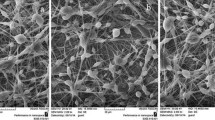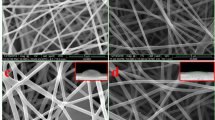Abstract
Infections caused by antibiotic-resistant pathogens result in a delayed wound-healing process. As an approach to prevent infections, alternatives in the form of natural antimicrobial products have become public interest. Essential oils derived from plants are used as antimicrobials owing to their broad-spectrum activity against pathogenic organisms. In this study, essential oil from seeds of watermelon, jackfruit, and papaya was incorporated into poly-ε-caprolactone/gelatin nanofibers using an electrospinning technique. The synthesized nanofibers were smooth, continuous, and bead-free. The nanofibers were found to be mechanically competent as confirmed by the universal tensile tester. The antibacterial activity of the various essential oil-loaded nanofibrous mats was determined by disc diffusion assay. Furthermore, they were found to be non-toxic and biocompatible by MTT and CMFDA assays on fibroblast cells. The obtained results have demonstrated that essential oil-loaded nanofiber mats are promising alternatives to conventional antibacterial wound dressings.









Similar content being viewed by others
Data Availability
The datasets generated and/or analyzed during the current study are available from the corresponding author on reasonable request.
References
Monika, P., Chandraprabha, M. N., Rangarajan, A., Waiker, P. V., & Chidambara Murthy, K. N. (2021). Challenges in healing wound: Role of complementary and alternative medicine. Frontiers in Nutrition, 8 791899 https://doi.org/10.3389/FNUT.2021.791899
Shadmi, E., Chen, Y., Dourado, I., Faran-Perach, I., Furler, J., Hangoma, P., & Willems, S. (2020). Health equity and COVID-19: Global perspectives. International Journal for Equity in Health, 19(1), 1–16. https://doi.org/10.1186/s12939-020-01218-z
Sarheed, O., Ahmed, A., Shouqair, D., & Boateng, J. (2016). Antimicrobial dressings for improving wound healing. Wound Healing - New insights into Ancient Challenges. https://doi.org/10.5772/63961
Williamson, D. A., Carter, G. P., & Howden, B. P. (2017). Current and emerging topical antibacterials and antiseptics: Agents, action, and resistance patterns. Clinical Microbiology Reviews, 30, 827–860.
Qin, J., Chen, F., Wu, P., & Sun, G. (2022). Recent advances in bioengineered scaffolds for cutaneous wound healing. Frontiers in Bioengineering and Biotechnology, 10, 244. https://doi.org/10.3389/FBIOE.2022.841583/BIBTEX
Fabio, G., Romanucci, V., Marino, C., Pisanti, A., & Zarrelli, A. (2015). Gymnema sylvestre R. Br., an Indian medicinal herb: Traditional uses, chemical composition, and biological activity. Current pharmaceutical biotechnology, 16(6), 506–516 https://doi.org/10.2174/138920101606150407112903
Johnston, M., McBride, M., Dahiya, D., Owusu-Apenten, R., & Nigam, P. S. (2018). Antibacterial activity of Manuka honey and its components: An overview. AIMS Microbiology, 4(4), 655. https://doi.org/10.3934/MICROBIOL.2018.4.655
Sharmeen, J. B., Mahomoodally, F. M., Zengin, G., & Maggi, F. (2021). Essential oils as natural sources of fragrance compounds for cosmetics and cosmeceuticals. Molecules, 26(3), 666. https://doi.org/10.3390/MOLECULES26030666
Bhavaniramya, S., Vishnupriya, S., Al-Aboody, M. S., Vijayakumar, R., & Baskaran, D. (2019). Role of essential oils in food safety: Antimicrobial and antioxidant applications. Grain & Oil Science and Technology, 2(2), 49–55. https://doi.org/10.1016/J.GAOST.2019.03.001
Sadekuzzaman, M., Yang, S., Mizan, M. F. R., & Ha, S. D. (2015). Current and recent advanced strategies for combating biofilms. Comprehensive Reviews in Food Science and Food Safety, 14(4), 491–509. https://doi.org/10.1111/1541-4337.12144
Vaughn, A. R., Clark, A. K., Sivamani, R. K., & Shi, V. Y. (2018). Natural oils for skin-barrier repair: Ancient compounds now backed by modern science. American journal of clinical dermatology, 19(1), 103–117. https://doi.org/10.1007/S40257-017-0301-1
Moore, E. M., Wagner, C., & Komarnytsky, S. (2020). The enigma of bioactivity and toxicity of botanical oils for skin care. Frontiers in Pharmacology, 11, 1–17. https://doi.org/10.3389/fphar.2020.00785
Brandao, R. M., Cardoso, M., & das G., Batista, L. R., Caetano, A. R. S., Lemos, A. C. C., Martins, M. A., … De Oliveira, J. E. (2022). Antifungal and physicochemical properties of Ocimum essential oil loaded in poly(lactic acid) nanofibers. Letters in Applied Microbiology, 74(5), 765–776. https://doi.org/10.1111/LAM.13661
Ullah, A., Saito, Y., Ullah, S., Haider, M. K., Nawaz, H., Duy-Nam, P., & Kim, I. S. (2021). Bioactive sambong oil-loaded electrospun cellulose acetate nanofibers: Preparation, characterization, and in-vitro biocompatibility. International Journal of Biological Macromolecules, 166, 1009–1021. https://doi.org/10.1016/j.ijbiomac.2020.10.257
Akter, F., & Haque, M. (2020). Jackfruit waste: A promising source of food and feed. Annals of Bangladesh Agriculture, 23(1), 91–102. https://doi.org/10.3329/aba.v23i1.51477
Angelova-Romova, M. Y., Simeonova, Z. B., Petkova, Z. Y., Antova, G. A., & Teneva, O. T. (2019). Lipid composition of watermelon seed oil. Bulgarian Chemical Communications, 51(August), 268–272.
Dotto, J. M., & Abihudi, S. A. (2021). Nutraceutical value of Carica papaya: A review. Scientific African, 13, e00933. https://doi.org/10.1016/j.sciaf.2021.e00933
Liu, Y., Zhou, S., Gao, Y., & Zhai, Y. (2019). Electrospun nanofibers as a wound dressing for treating diabetic foot ulcer. Asian Journal of Pharmaceutical Sciences, 14(2), 130–143. https://doi.org/10.1016/j.ajps.2018.04.004
Zhang, Q., Oh, J., Park, C. H., Baek, J., Ryoo, H., & Woo, K. M. (2017). Effects of dimethyloxalylglycine-embedded poly (ε-caprolactone) fiber meshes on wound healing in diabetic rats. ACS applied materials & interfaces, 9(9), 7950–7963. https://doi.org/10.1021/acsami.6b15815
Ramalingam, R., Dhand, C., Mayandi, V., Leung, C. M., Ezhilarasu, H., Karuppannan, S. K., & Arunachalam, K. D. (2021). Core-shell structured antimicrobial nanofiber dressings containing herbal extract and antibiotics combination for the prevention of biofilms and promotion of cutaneous wound healing. ACS Applied Materials and Interfaces, 13, 24356–24369. https://doi.org/10.1021/acsami.0c20642
Ramalingam, R., Dhand, C., Leung, C. M., Ong, S. T., Annamalai, S. K., Kamruddin, M., & Arunachalam, K. D. (2019). Antimicrobial properties and biocompatibility of electrospun poly-ε-caprolactone fibrous mats containing Gymnema sylvestre leaf extract. Materials Science & Engineering C, 98, 503–514. https://doi.org/10.1016/j.msec.2018.12.135
Ramalingam, R., Dhand, C., Leung, C., Ezhilarasu, H., Prasannan, P., Ong, S., & Arunachalam, K. (2019). Poly-ε-caprolactone/gelatin hybrid electrospun composite nanofibrous mats containing ultrasound assisted herbal extract: Antimicrobial and cell proliferation study. Nanomaterials, 9(3), 462. https://doi.org/10.3390/nano9030462
Hernández-Santos, B., Rodríguez-Miranda, J., Herman-Lara, E., Torruco-Uco, J. G., Carmona-García, R., Juárez-Barrientos, J. M., & Martínez-Sánchez, C. E. (2016). Effect of oil extraction assisted by ultrasound on the physicochemical properties and fatty acid profile of pumpkin seed oil (Cucurbita pepo). Ultrasonics Sonochemistry, 31, 429–436. https://doi.org/10.1016/j.ultsonch.2016.01.029
Jin, G., Prabhakaran, M. P., Kai, D., Kumar, S., Arunachalam, K. D., & Ramakrishna, S. (2013). Tissue engineered plant extracts as nanofibrous wound dressing. Biomaterials, 34(3), 724–734. https://doi.org/10.1016/j.biomaterials.2012.10.026
Dai, X., Liu, J., Zheng, H., Wichmann, J., Hopfner, U., Sudhop, S., & Schilling, A. F. (2017). Nano-formulated curcumin accelerates acute wound healing through Dkk-1-mediated fibroblast mobilization and MCP-1-mediated anti-inflammation. NPG Asia Materials, 9(3), e368. https://doi.org/10.1038/am.2017.31
Verma, N. K., Conroy, J., Lyons, P. E., Coleman, J., O’Sullivan, M. P., Kornfeld, H., & Volkov, Y. (2012). Autophagy induction by silver nanowires: A new aspect in the biocompatibility assessment of nanocomposite thin films. Toxicology and Applied Pharmacology, 264(3), 451–461. https://doi.org/10.1016/j.taap.2012.08.023
Dhand, C., Venkatesh, M., Barathi, V. A., Harini, S., Bairagi, S., Leng, G. T., & E., …Lakshminarayanan, R. (2017). Bio-inspired crosslinking and matrix-drug interactions for advanced wound dressings with long-term antimicrobial activity. Biomaterials, 138, 153–168. https://doi.org/10.1016/j.biomaterials.2017.05.043
Zhang, L., Wang, Z., Xiao, Y., Liu, P., Wang, S., Zhao, Y., & Shi, X. (2018). Electrospun PEGylated PLGA nanofibers for drug encapsulation and release. Materials Science and Engineering C, 91, 255–262. https://doi.org/10.1016/j.msec.2018.05.045
Choy, S. Y., Prasad, K. M. N., Wu, T. Y., Raghunandan, M. E., Yang, B., Phang, S. M., & Ramanan, R. N. (2017). Isolation, characterization and the potential use of starch from jackfruit seed wastes as a coagulant aid for treatment of turbid water. Environmental Science and Pollution Research, 24(3), 2876–2889. https://doi.org/10.1007/s11356-016-8024-z
Rai, A., Mohanty, B., & Bhargava, R. (2015). Modeling and response surface analysis of supercritical extraction of watermelon seed oil using carbon dioxide. Separation and Purification Technology, 141, 354–365. https://doi.org/10.1016/j.seppur.2014.12.016
Senrayan, J., & Venkatachalam, S. (2019). A short extraction time of vegetable oil from Carica papaya L. seeds using continuous ultrasound acoustic cavitation: Analysis of fatty acid profile and thermal behavior. Journal of Food Process Engineering, 42(1), 1–9. https://doi.org/10.1111/jfpe.12950
Joshi, M. K., Tiwari, A. P., Pant, H. R., Shrestha, B. K., Kim, H. J., Park, C.-H., & Kim, C. S. (2015). In situ generation of cellulose nanocrystals in polycaprolactone nanofibers: Effects on crystallinity, mechanical strength, biocompatibility, and biomimetic mineralization. ACS Applied Materials and Interfaces, 7(35), 19672–19683.
Wong, S. C., Baji, A., & Leng, S. (2008). Effect of fiber diameter on tensile properties of electrospun poly(ε-caprolactone). Polymer, 49(21), 4713–4722. https://doi.org/10.1016/j.polymer.2008.08.022
Kim, H. H., Kim, M. J., Ryu, S. J., Ki, C. S., & Park, Y. H. (2016). Effect of fiber diameter on surface morphology, mechanical property, and cell behavior of electrospun poly(ε-caprolactone) mat. Fibers and Polymers, 17(7), 1033–1042. https://doi.org/10.1007/s12221-016-6350-x
Wojtowicz, A. M., Oliveira, S., Carlson, M. W., Zawadzka, A., Rousseau, C. F., & Baksh, D. (2014). The importance of both fibroblasts and keratinocytes in a bilayered living cellular construct used in wound healing. Wound Repair and Regeneration, 22, 246–245. https://doi.org/10.1111/wrr.12154
Ezhilarasu, H., Ramalingam, R., Dhand, C., Lakshminarayanan, R., Sadiq, A., Gandhimathi, C., & Srinivasan, D. K. (2019). Biocompatible aloe vera and tetracycline hydrochloride loaded hybrid nanofibrous scaffolds for skin tissue engineering. International journal of molecular sciences, 20(20), 5174. https://doi.org/10.3390/ijms20205174
de la Cruz, X. M., Mandujano-Chávez, A., Browne, D. R., Devarenne, T. P., Sánchez-Segura, L., López, M. G., & Lozoya-Gloria, E. (2021). In silico and cellular differences related to the cell division process between the a and b races of the colonial microalga botryococcus braunii. Biomolecules, 11(10), 1463. https://doi.org/10.3390/BIOM11101463/S1
Jaganathan, S. K., & Mani, M. P. (2019). Single-stage synthesis of electrospun polyurethane scaffold impregnated with zinc nitrate nanofibers for wound healing applications. Journal of Applied Polymer Science, 136(3), 1–9. https://doi.org/10.1002/app.46942
Jaganathan, S. K., Mani, M. P., & Khudzari, A. Z. M. (2019). Electrospun combination of peppermint oil and copper sulphate with conducive physico-chemical properties for wound dressing applications. Polymers, 11(4), 586. https://doi.org/10.3390/POLYM11040586
Barzegar, S., Zare, M. R., Shojaei, F., Zareshahrabadi, Z., Koohi-Hosseinabadi, O., Saharkhiz, M. J., … Khorram, M. (2021). Core-shell chitosan/PVA-based nanofibrous scaffolds loaded with Satureja mutica or Oliveria decumbens essential oils as enhanced antimicrobial wound dressing. International Journal of Pharmaceutics, 597 120288 https://doi.org/10.1016/J.IJPHARM.2021.120288
Lee, J. Y., Yoon, D., Son, B. C., Rezk, A. I., Park, C. H., & Kim, C. S. (2020). Antimicrobial electrospun nanofibrous mat based on essential oils for biomedical applications. Journal of nanoscience and nanotechnology, 20(9), 5376–5380. https://doi.org/10.1166/JNN.2020.17669
Sofi, H. S., Akram, T., Tamboli, A. H., Majeed, A., Shabir, N., & Sheikh, F. A. (2019). Novel lavender oil and silver nanoparticles simultaneously loaded onto polyurethane nanofibers for wound-healing applications. International Journal of Pharmaceutics, 569 118590 https://doi.org/10.1016/J.IJPHARM.2019.118590
CengizÇallioǧlu, F., KesiciGüler, H., & SesliÇetin, E. (2019). Emulsion electrospinning of bicomponent poly (vinyl pyrrolidone)/gelatin nanofibers with thyme essential oil. Materials Research Express, 6(12), 125013. https://doi.org/10.1088/2053-1591/AB5387
Acknowledgements
The authors thank the Department of Physics and Nanotechnolgy, and SCIF, SRM Institute for Science and Technology for providing the facilities to carry out this research work.
Author information
Authors and Affiliations
Contributions
Conceptualization: RR, JT; methodology: RR; formal analysis and investigation: VS; writing — original draft preparation: VS; writing — review and editing: RR; resources: KDA; supervision: JT, KDA. All authors read and approved the final manuscript.
Corresponding authors
Ethics declarations
Ethics Approval
Not applicable.
Consent to Participate
Not applicable.
Consent to Publish
Not applicable.
Competing Interests
The authors declare no competing interests.
Additional information
Publisher's Note
Springer Nature remains neutral with regard to jurisdictional claims in published maps and institutional affiliations.
Rights and permissions
Springer Nature or its licensor (e.g. a society or other partner) holds exclusive rights to this article under a publishing agreement with the author(s) or other rightsholder(s); author self-archiving of the accepted manuscript version of this article is solely governed by the terms of such publishing agreement and applicable law.
About this article
Cite this article
Sadaiyandi, V., Ramalingam, R., Arunachalam, K.D. et al. Essential Oils Infused Poly-ε-Caprolactone/Gelatin Electrospun Nanofibrous Mats: Biocompatibility and Antibacterial Study. Appl Biochem Biotechnol 196, 296–313 (2024). https://doi.org/10.1007/s12010-023-04530-w
Accepted:
Published:
Issue Date:
DOI: https://doi.org/10.1007/s12010-023-04530-w




